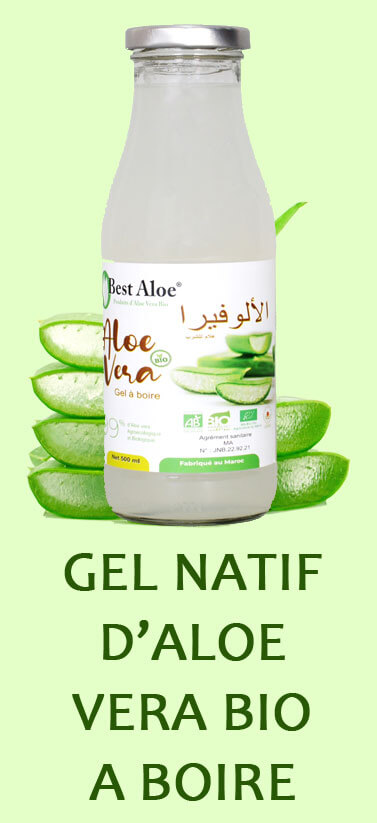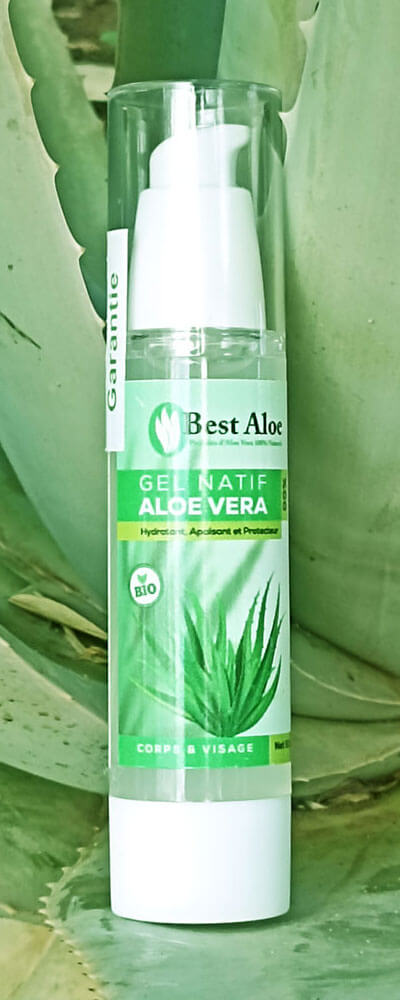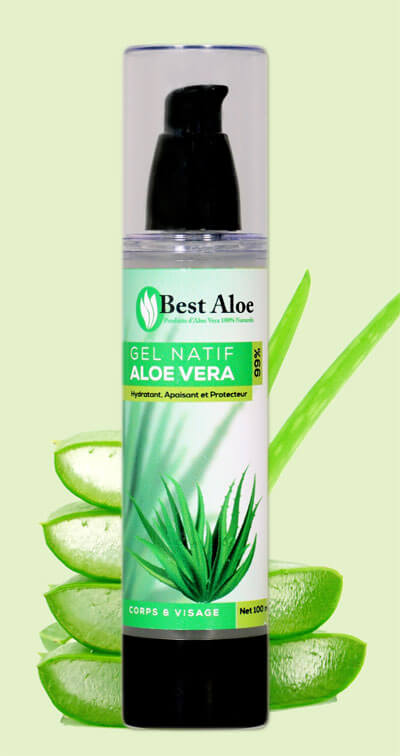Virtuous plant whose origin is uncertain, Aloe Vera is known since ancient Mesopotamia and Egypt of the pharaohs for its benefits.
What is Aloe Vera?
Aloe vera or aloe barbadensis belongs to the lily family and is part of the monocot class. It is a plant with shallow roots that grows on sandy and calcareous soils of semi-desert regions with a hot and dry climate.
Its very short and woody stem bears a bundle of smooth fleshy leaves of green color, with triangular section, with pointed ends, the largest of which can reach 80 cm in height and 10 cm in their largest width with edges provided with light yellow spines.
The cross section of a leaf makes it possible to distinguish, from the outside to the inside: the cuticle, an epidermal layer, a cellulosic dermis where a brownish red sap (aloin) circulates, and finally in the center a thick pulp, a colourless mucilaginous parenchyma which is the precious juice used for its beneficial virtues.
Aloe Vera: a little history

The etymology of this plant draws its roots from the Greek “αλόη” translated “aloe” in Latin.
Even today, the origin of aloe vera is uncertain. In antiquity, the Egyptians, Greeks, or Romans had already resorted to the juice extracted from its leaves. The oldest medical document, the payprus Eders, cites it as a medicinal plant.
The species then settled in Africa, Asia or the Caribbean.
Analytical composition of Aloe Vera:

Aloe vera has an average pH of 4.5 (very close to that of the skin), and contains the following components:
VITAMINS: A, B1, B2, B3, B6, B9, B12, C, E, choline: aloe is one of the few plants containing vitamin B12.
MINERALS: calcium, phosphorus, potassium, iron, sodium, chlorine, manganese, magnesium, copper, chromium, zinc …. Aloe contains more than 20 minerals which, although necessary only in very small quantities, are important for the correct functioning of the various enzyme systems.
ENZYMS: amylase, lipase, phosphoric creatine… Enzymes (when we drink aloe juice) support many of the biochemical catalysts during digestion by breaking down fats and sugars and bradykinase relieves inflammation and pain in the skin (this anti-inflammatory action is reinforced by the presence of silicic acid).
SUGARS: mono and polysaccharides: they develop the immune system and help detoxify the body.
AMINOACIDS: phenylalanine, leucine, lysine … these are proteins that provide energy, act as catalysts, regulate the chemical balance and are involved in tissue regeneration. Aloe contains 18 of the 22 amino acids found in the human body, including 7 of the 8 essential AA.
SAPONINS: cleansing and antiseptics
LIGNIN: it gives aloe a unique penetrating effect, which promotes the absorption of the other components by the skin.
ANTHRAQUINONES: in small quantities they support the gastrointestinal activity and have antibiotic and analgesic actions.
Cosmetological properties of Aloe Vera:

Because of its extraordinary cutaneous effects: rebalancing of the cutaneous pH, desquamation of the dead cells of the epidermis, hydration and nourishment of the skin in depth, stimulation of the cellular multiplication of the fibroblasts of the dermis, which make of the pulp of aloe vera a true cutaneous “regenerating”. Its actions are further enhanced by its astringent, softening and protective properties, which make it one of the most remarkable natural beauty products available.
Acting directly on collagen fibers, aloe gels provide elasticity to the skin. Their multitude of complex polysaccharides are able to retain large amounts of water (moisturizing effect) making the skin smooth and elastic, resorbing wrinkles. Although deeply penetrating, aloe gels create a moisturizing film on the surface of the skin that protects against wind, salt, sun or dirty particles. (Cf References)
The dermatological properties of Aloe Vera:
Because of its actions: hemostatic, anesthetic, bactericidal, healing and anti-inflammatory (linked to many of its components, acting in synergy) which are all important in promoting the healing of a large part of traumatic (wounds, burns, irritations, etc.) or non-traumatic (dermatoses in general) skin pathology.
Applications of aloe vera in the cosmetic and dermatological sphere
(through local external use):

- Hydration: Aloe gel has a moisturizing power because it penetrates inside the skin 3 to 4 times faster than water and 7 times deeper (Dr. Danhof, 1984).
- Premature aging of the skin: Collagen Production: Aloe Vera Gel would accelerate on a tired skin from 6 to 8 times the production of human fibroplasts, compared to the normal rhythm of cellular reproduction. Responsible for the production of collagen, the skin’s main protein carrier, fibroplasts are cells whose activity conditions the aging of the dermis and the appearance of wrinkles. According to Danhof, it is the polysaccharides in Aloe vera gel that facilitate the reorganization of the cells of the thin protective barrier provided by the stratum corneum of the epidermis. (Doctor E.Danhof, 1984, Ref. Aloe, the healing plant).
- Stretch marks (preventively and curatively)
- Seborrheaof the scalp
- Psoriasis, some forms of eczema: Aloe gel can be a palliative treatment for patients with psoriasis (Dr. Syed, 1996).
- Burns at all degrees (including sunburns which are 1st degree burns) and whatever the causes: fire, boiling liquids, electricity, X-rays, etc… (1st traditional use of the Indians).
- Frostbite, chapping, blisters, redness (erythema) and skin irritations in general, abrasions, cuts, herpes, ulcerations in general, as well as all slow and difficult healing: Aloe Vera has the power to accelerate tissue renewal thanks to its biogenic stimulators (Doctor Filatov, 1945).
- Insect bites and itching
- Arthritis and Osteoarthritis: Conventional treatments based on anti-inflammatory drugs can have harmful effects on the digestive system and can also hinder the production of GAGs, substances synthesized by chondrocytes (cartilage cells). Aloe Vera in local application and orally increases the synthesis of GAGs and also has natural anti-inflammatory properties.
Directions for use of our native organic Aloe Vera gel (Cosmetic grade)

Thanks to its healing, anti-inflammatory, moisturizing, softening, protective and collagen-stimulating virtues, our Aloe Vera is perfectly indicated for cosmetic products: it can be added to the aqueous phase and replace all or part of the water in the formula with our pure organic aloe vera gel.
It is recommended not to heat it to more than 80°C during application in order to preserve its properties as much as possible.
Storage precautions:
Aloe vera, like most natural products, is sensitive to heat, light and oxygen. It may darken over time and present a slight precipitate. These changes do not affect its effectiveness To optimize its conservation, it is recommended to store it in the refrigerator between 5°C and 10°C.
Partager cet article sur les réseaux sociaux:
- Click to share on Facebook (Opens in new window) Facebook
- Click to share on WhatsApp (Opens in new window) WhatsApp
- Click to share on X (Opens in new window) X
- Click to share on LinkedIn (Opens in new window) LinkedIn
- Click to share on Pinterest (Opens in new window) Pinterest
- Click to print (Opens in new window) Print
- Click to email a link to a friend (Opens in new window) Email





